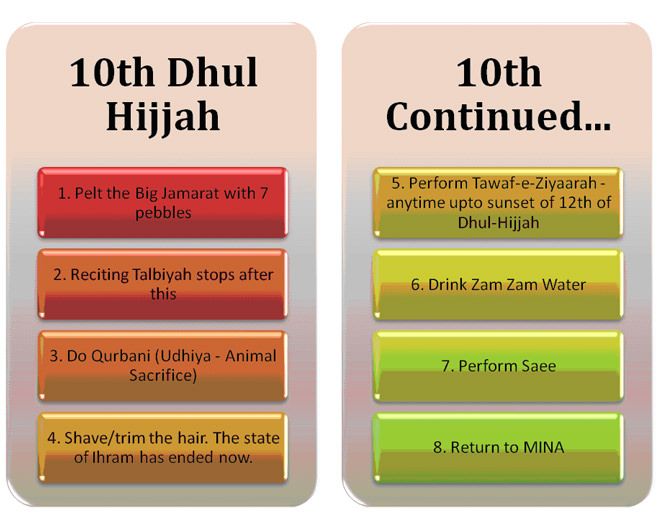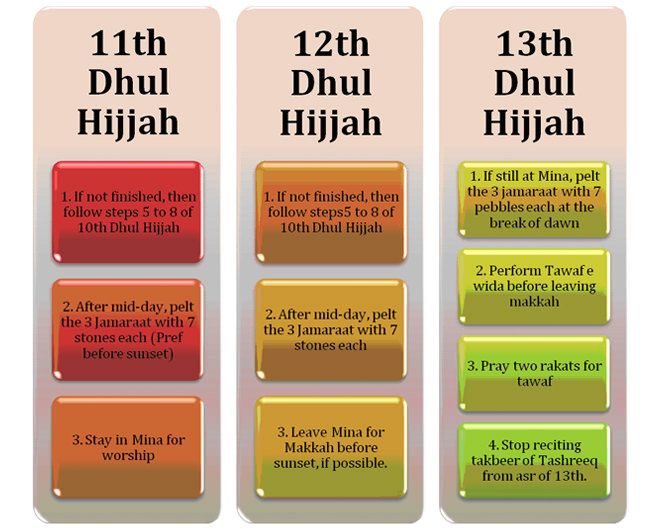It is known that throwing the pebbles on the days of Tashriq is done after the sun has passed the zenith. It is not permissible to throw them, nor will it be valid if thrown before this time. The throwing period continues till sunset. If a pilgrim is compelled to delay throwing the pebbles till night, there is nothing wrong with that.

The throwing is done in the following manner:
- The pilgrim starts with the first stone pillar (Al jamratulula) and pelts it with seven pebbles consecutively. He says Allahu Akbar with each pebble he throws. It is desirable that he moves forward a little bit and stands on the right side of the stone pillar. He then faces the Qiblah, raises his hands, and makes a long supplication if possible.
- He then casts seven pebbles at the middle stone pillar (Al-jamratul-Wusta) with seven pebbles successively. He says Allahu Akbar with each pebble he throws. It is desirable that he moves forward a little bit and stands on the left side of the stone pillar. He then faces the Qiblah, raises his hands, and makes supplication that is as nearly as long as he did at the first stone pillar if it is easily possible.
- He then moves to the third stone pillar (jamratul – Aqabah) and stands in the direction of Makkah on his left side and Mina on his right side. He says Allah Akbar with each pebble he throws, but he does not need to make any supplication after throwing the pebbles here.
- There are six occasions in which the pilgrim is required to stand and make supplication during his Hajj On the mountain of Safa, on the mountain of Marwah (both during say’ee) at Arafah in Muzdalifah at Al Mash arul Haram, after throwing pebbles at the first stone pillar and after throwing pebbles at the middle stone pillar.
- The honorable pilgrim ensures that the thrown pebbles fall inside the hollow. He is not required to ensure that they stay inside it. It is better to carry out this rite any time of the day after the sun has passed the zenith. If maintaining this time is difficult, he can perform it later in the night.
- It is recommended that he stays in Mina for the tashreeq days and avoids the luxury of passing the night in Makkah or staying there during the day, searching for ease and enjoyment under air-conditioned rooms to escape from the heat of the sun. Though spending daytime hours outside of Mina is regarded as permissible according to the jurists, based upon the ruling that it is passing the nights, only that is required, yet it is against the sunnah. The prophet (PBUH) remained in Mina for the days and nights of Tashreeq. However, if a person needs to stay out of Mina during daylight hours due to some indisposition or be a companion of an indisposed person, there is nothing wrong.
- It is obligatory to pass the nights of Tashriq in Mina. Passing the night outside the boundaries of Mina is against the sunnah of the prophet (PBUH). Therefore staying within the borders of mina is an obligation this is due to the prophet’s instruction:
“ Take your Hajj rites from me.”

The prophet (PBUH) stayed in Mina. However, he permitted Abbas ibn AdilMuttalib to pass the night in Makkah due to his responsibility of providing water for the pilgrims.
- If the pilgrim hastens to leave Mina on the twelfth day of DhulHijjah after throwing the pebbles at the Jamarat and before the sun sets, he has committed no violation, and he is not obliged to throw the pebbles on the thirteenth day. However, he should not leave Makkah before performing the farewell Tawaf.
